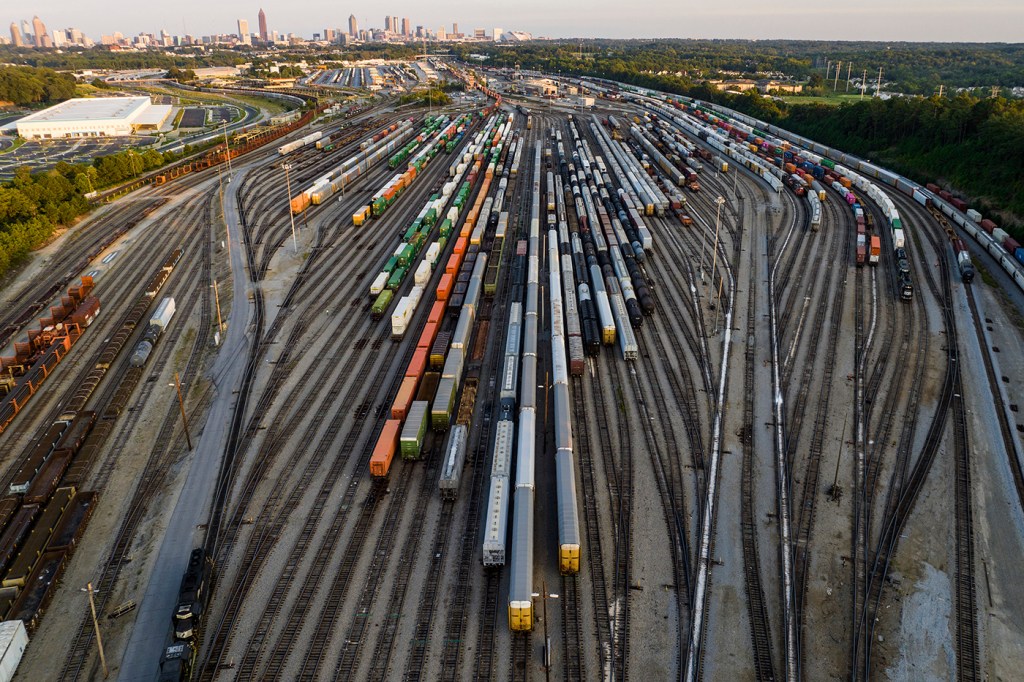Rail strike would be ‘absolutely catastrophic’ to supply chains, Northeastern expert warns

President Joe Biden celebrated Thursday a tentative labor agreement that averted a strike of U.S. freight trains. But the crisis has not yet been averted, warns Nada Sanders, distinguished professor of supply chain management at Northeastern.

“I’m not 100% confident by any means,” says Sanders, noting that union members will be voting on the deal next month after a cooling-off period.
The agreement, which delivers a 24% pay increase, resulted from 20 hours of negotiations on the eve of a potential strike. Labor Secretary Marty Walsh mediated the talks at his offices in Washington, D.C.
Sanders says the impact of a rail strike would be “absolutely catastrophic” for supply chains that have been reeling since the COVID-19 pandemic.Sanders spoke with News@Northeastern on Friday about the potential ramifications of a rail strike, why labor has leverage over management, and how supply chains are being reinvented in real-time. Her comments have been edited for brevity and clarity.
How much do U.S. supply chains rely on railroads?
It would take about 450 trucks to actually replace one long freight train. Overall, about one-third of freight is transported via rail. But that’s not the full picture.
If you think about how rail works, these are items that are being moved in bulk in these large containers. A lot of the items are going to be used as ingredients for other products—lumber, paint, agricultural products, chemicals for water treatment plants, food items including feed for livestock.
People don’t realize the importance of this main artery that feeds all of these raw ingredients into so many different products in the broader supply chain.
What would be the impact of a rail strike?
I don’t even want to imagine what it would do to prices in a supply chain that is so fragile—and coupling that with inflation, the consumer price index and all the other metrics.
We can’t get rid of rail, which is extremely inexpensive compared to trucking or air transport. It’s an intricate logistics network. If this were to shut down, it would be absolutely catastrophic—something like $2 billion per day in economic impact.
What are the chances that union members vote down this agreement and demand more concessions?
This is not a done deal. I’m not an expert on labor and I don’t know what’s going on behind the scenes, but workers clearly can see all the discussion in the popular press about the dangers of a proposed strike and they definitely have an upper hand.
It shows that we are in a very different era.
Supply chains have regained strength since the low point of the COVID-19 pandemic. But how would you gauge the state of supply chains overall?
I would say it’s in this very dynamic period of evolution. And it’s changing very quickly.
Look at how many facilities Amazon is closing that it opened up during the pandemic. I’m bringing up Amazon in the bigger picture because, as stellar as they are in all the analytics and algorithms that they have, they couldn’t forecast out far enough. They opened up facilities only to close them.
Things are better than they were. But we are in a very turbulent time. The entire business cycle is rapidly shifting and the window of change is so short now.
What is the key to understanding the new supply chains?
There are a lot of variables because so many things have to be optimized. It’s very dynamic and requires a whole new way of thinking.
Which items do I want? How many? Where do I locate them? This is where analytics comes in. There’s a real art to it—which metrics do I look at?
Even companies that are sophisticated like Amazon, Walmart, Target, Nordstroms—they find themselves being stuck with inventories because it’s so challenging and we are in a fast-moving landscape.
Will we look back and say that the pandemic forced businesses to create more sophisticated supply chains?
Yes. But we also have to realize that as consumers we’ve been spoiled by the lean supply chains that existed before COVID. Products don’t come just simply from pressing the button and Amazon magically delivers them to our doorstep.
As consumers we have to brace ourselves for the fact that it will cost us more and we will have fewer choices. But isn’t that better than not having products?
For media inquiries, please contact media@northeastern.edu.






